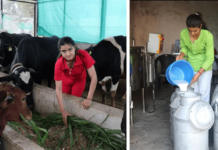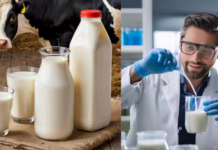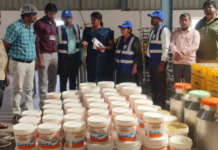Washington, January 13, 2022: As U.S. President Joe Biden’s administration seeks to revive its ambitious social spending and climate plan in Congress, environmental groups and the farm industry are at odds over proposed subsidies aimed at offsetting agriculture’s substantial contribution to global warming.
Tax credits and grants proposed in the administration’s sweeping “Build Back Better” bill(BBB) would bolster the small but fast-growing market for manure-based methane gas by supporting construction of machines that trap the gas from open manure pits on dairy farms and other livestock operations. Farmers could then sell the trapped methane for use in generating electricity or vehicle fuel in the form of compressed natural gas.
The proposed incentives have been hailed by dairy farmers and investors as a “game changer” that could pad farm incomes while combating climate change by providing a less-polluting alternative to fossil fuels. The industry that produces gas from organic waste says subsidies would boost the development of the machinery.
But some environmental groups and Democratic lawmakers have lined up against the subsidies, saying they could backfire because if capturing and selling methane from cows becomes profitable, it could incentivize large farms to grow, increasing greenhouse gas emissions. They warn that supporting a market for biomethane fuel would delay a transition to an all-electric future.
“If you start making money off of pollution, you’re not going to stop polluting,” said Rebecca Wolf, policy analyst at environmental group Food & Water Watch.
The debate, which has intensified as use of the technology has expanded, reflects the difficulties of reducing emissions from dairies due to growing cow herds and a lack of commercially available technologies to reduce methane, which is produced both by manure and animal digestion.
Methane, a potent greenhouse gas that has a higher heat-trapping potential than carbon dioxide (CO2), is the second-biggest cause of climate change behind CO2.
Senate Democrats’ full support is needed to pass the BBB spending package, which has garnered no backing from Senate Republicans. Democrats were unable to pass the bill last month but say they hope to do so in some form this year.
Some Democrats are critical of these methane-trapping machines, known as anaerobic digesters. Sen. Cory Booker, a New Jersey Democrat, told Reuters that money in the plan should instead be “targeted to family farmers for soil health and regenerative agriculture practices,” such as planting cover crops and employing no-till farming.
West Virginia Senator Joe Manchin, a Democrat whose opposition to the spending plan led to its failure to pass the Senate in December, this month expressed support for clean-energy tax credits, bolstering the industry’s optimism that the plan could still be enacted.
Livestock methane pollution accounts for more than a third of U.S methane emissions, according to the U.S. Environmental Protection Agency (EPA). Digesters are mainly found at dairies because milking cows produce more manure than beef cattle.
The spending plan would make digester owners eligible for a 30% tax credit and put billions of dollars into U.S Department of Agriculture (USDA) programs that could help digester companies offset their costs.
Digester developers and investors say the criticism from green groups is a distraction from efforts to combat climate change.
“What’s the alternative?” said Bob Powell, chief executive of San Francisco-based digester developer Brightmark LLC. “More methane into the air.”
MISSED GOALS
A previous deal between the administration of former President Barack Obama and the dairy industry to promote digesters failed badly in reducing emissions, according to a Reuters review of government documents and data.
In 2009, the Obama administration and an industry group, the Innovation Center for U.S. Dairy, pledged to reduce the industry’s greenhouse gas emissions by 25% by 2020 over levels in 2007, in part by expanding federal support for new digesters.
Instead, methane emissions in the sector have risen more than 15%, in part driven by growth in herd size, according to EPA data reviewed by Reuters. The number of dairy cows nationwide has grown 3.3% since 2009, according to USDA data, to 9.39 million cows according to the reports published in reuters.com.
The dairy industry has since pledged to become greenhouse gas neutral by 2050, and the USDA will continue to work with the industry to meet that goal, according to an agency official. Current agriculture secretary Tom Vilsack was also secretary under Obama.
The industry missed the 2020 goal in part because digesters were so expensive and there was no market then for the gas they captured, according to the Innovation Center’s Karen Scanlon, executive vice president of environmental stewardship, and Jim Wallace, senior vice president of environmental research.
Digesters are pricey, typically costing between $4 million and $7 million each, and often require dedicated staff to run them. Digesters also don’t capture the 27% of U.S. methane emissions that come from livestock enteric fermentation, or cow burps, for which there is no commercial-scale solution.
But the landscape has changed, industry officials said, because since 2017 digesters have been able to generate lucrative credits for the biogas industry under a California policy called the Low Carbon Fuel Standard. Even out-of-state producers can claim the credits if the gas they produce is piped to fuel the state’s’ trucks and buses.
The value of those credits has roughly doubled since dairy methane was included in the program, to around $200, and the policy has helped to “super-charge the industry,” Wallace said.
In a sign of the controversy around digesters, however, environmental groups in October petitioned the California Air Resources Board (CARB) to make them ineligible for credits, arguing that their presumed role in combating climate change was inflated and that the credits encourage making more manure. California is the top dairy state and the industry is responsible for more than half of the state’s methane emissions.
CARB said it is evaluating the petition.
Meanwhile the state is doubling down on the technology, and CARB has said it may need to spend between $700 million and $3.9 billion to build 200 additional digesters to help meet a goal it set in 2016 to reduce dairy methane emissions by 40% below 2013 levels by 2030. The cost depends on whether the digesters would be paired with polluting internal combustion engines or cleaner but far more expensive fuel cells.
The state is currently on track to meet only half its emissions-reduction goal, after spending nearly $200 million on digesters since 2015.
“We think we can realize the rest of the reductions that we’re hoping to see through additional digesters, as well as some other reduction processes,” said Ryan Schauland, acting chief of the project assessment branch of CARB.
Investment in U.S. biogas projects has already tripled since 2017 to more than $1.6 billion, according to data from research firm AcuComm, including from players like oil companies Chevron (CVX.N) and BP , as well as car maker BMW, which are seeking to cash in on the biogas market and its subsidies.
There are currently 317 operational manure digesters nationally, up from 141 in 2009, according to EPA data.
At the moment, digesters favor large farms. One 2018 study of the potential for dairy biogas in Idaho found that a farm needed at least 3,000 cows for an “economically viable” digester operation. Just 714 of the U.S. roughly 40,000 dairy farms have 2,500 cows or more, according to the most recent USDA census.
But the proposed incentives in BBB could benefit some smaller farms, said Jed Davis, head of sustainability at Cabot Creamery in Vermont. He said six of Cabot’s farms have digesters and more are in development.
“I’m not imagining a future where every farm uses anaerobic digestion,” Davis said. “But I’m bullish on the fact that there is more opportunity than is currently available.”


































